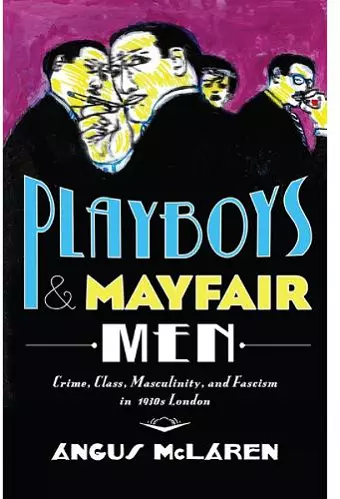Playboys and Mayfair Men
Crime, Class, Masculinity, and Fascism in 1930s London
Format:Hardback
Publisher:Johns Hopkins University Press
Published:31st Oct '17
Should be back in stock very soon

Angus McLaren is the most imaginative, productive, and thorough scholar I know in the history of modern sexuality and gender studies. Clear, witty, and thematically rich, his engaging book effectively brings alive the social, cultural, and urban scene of 1930s London in a way that readers of crime dramas and mystery thrillers will enjoy. A tour de force. -- Robert A. Nye, author of Crime, Madness and Politics in Modern France: The Medical Concept of National Decline
An original and exciting cultural history of 1930s Britain, this innovative book and the exploits of its dissolute playboys will appeal to true-crime readers and historians alike.In December 1937, four respectable young men in their twenties, all products of elite English public schools, conspired to lure to the luxurious Hyde Park Hotel a representative of Cartier, the renowned jewelry firm. There, the "Mayfair men" brutally bludgeoned diamond salesman Etienne Bellenger and made off with eight rings that today would be worth approximately half a million pounds. Such well-connected young people were not supposed to appear in the prisoner's dock at the Old Bailey. Not surprisingly, the popular newspapers had a field day responding to the public's insatiable appetite for news about the upper-crust rowdies and their unsavory pasts. In Playboys and Mayfair Men, Angus McLaren recounts the violent robbery and sensational trial that followed. He uses the case as a hook to draw the reader into a revelatory exploration of key interwar social issues from masculinity and cultural decadence to broader anxieties about moral decay. In his gripping depiction of Mayfair's celebrity high life, McLaren describes the crime in detail, as well as the police investigation, the suspects, their trial, and the aftermath of their convictions. He also* examines the origins and cultural meanings of the playboy-the male 1930s equivalent of the 1920s flapper; * includes in his cast of characters such well-known figures as Noel Coward, Evelyn Waugh, the Churchills, Robert Graves, Oswald Mosley, and Edward VIII; and* convincingly links disparate issues such as divorce reform, corporal punishment, effeminacy, and fascism. The trial is fascinating, not simply because of its four young louts but because it revealed for the first time in the media troubling aspects of British society which had escaped serious scrutiny. An original and exciting cultural history of 1930s Britain, this innovative book and the exploits of its dissolute playboys will appeal to true-crime readers and historians alike.
a detailed contextual analysis of the period and its obsessions.
—Times Higher Education
I found Playboys & Mayfair Men riveting.
—Literary Review
[McLaren] succeeds in extracting from a seedy tale some novel insights into the culture of pre-war Britain.
—New Statesman
McLaren uses an impressive range of sources, both primary and secondary, to plunge deeply into the world of Mayfair men not only in the 1930s but also in the postwar world. In a sense, they were the successors of the flappers and the Bright Young Things of the 1920s.
—Peter Stansky, Stanford University, Journal of Interdisciplinary History
The book is a delight to read, due largely to its effective organization, clear analysis of the playboy identity, and the timeliness of its portrayal of class and gendered entitlement . . . McLaren's style is compact and clear throughout, and the book would be an excellent addition to readers' lists for students interested in gender, class, and interwar Britain. On a more general level, the subject matter will appeal to anyone aware of the class privilege and playboy mentalities increasingly on display in our contemporary world.
—Brett Bebber, Old Dominion University, H-Net Reviews
Clearly written and well-organized . . . Playboys and Mayfair Men: Crime, Class, Masculinity, and Fascism in 1930s London makes a very useful addition to the growing literature on the history of masculinity . . . To read McLaren's book is to enter a world of outrageous snobbery that is not quite as remote from our own as many of us would like to believe.
—Dominic Janes, Keele University, American Historical Review
[Playboys and Mayfair Men] makes for an enjoyable read, demonstrating effectively the fascination that such high society cases could have for a wide readership, as much today as at the time they were reported . . . McLaren makes a number of interesting points about the socio-cultural significance of the case, principally around the importance of economic production and conspicuous consumption to definitions of masculinity in this period, which enables him to date the emergence of the playboy to two decades earlier than has generally been argued.
—Jessica Meyer, University of Leeds, English Historical Review
ISBN: 9781421423470
Dimensions: 229mm x 152mm x 23mm
Weight: 499g
272 pages